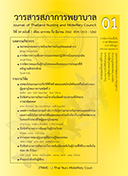Predictive Factors of Hypoglycaemia in Neonates Delivered by means of Caesarean Sections
Keywords:
hypoglycaemia, neonates, caesarean sectionsAbstract
Objective: To investigate factors that could predict occurrences of hypoglycaemia in neonates delivered
by means of caesarean sections.
Design: Retrospective case-control study.
Methodology: The study sample, obtained through simple random sampling, consisted of 260 neonates who were delivered by means of caesarean sections and admitted to the neonatal care units of Phra Chom Klao Hospital and Hua Hin Hospital. Half of the neonates were classifed as a study group and half of them as a control group based on the criteria. Data were collected through a retrospection of medical records and a hypoglycaemia prediction form. Descriptive statistics and logistic regression analysis were used for data
analysis.
Results: Body mass index (BMI), nothing-per-oral (NPO) duration, types of intravenous fluid
(IVF) for the mothers, and disproportionate birth weight for gestational age could jointly predict 74.3% of hypoglycaemia in neonates delivered by means of caesarean section (p < .01). First, neonates whose mothers had BMI ≥ 25 kg/m2 were 7.88 times more likely to develop hypoglycaemia than those whose mothers had BMI < 25 kg/m2 (95% CI: 3.23-19.18). Second, neonates whose mothers received NPO for ≥ 6 hours were 26.41 times more likely to develop hypoglycaemia than those whose mothers received NPO for < 6 hours (95% CI: 8.32-83.77). Next, neonates whose mothers were given glucose-free intravenous fluid displayed a 5.03-time greater likelihood to develop hypoglycaemia than those whose mothers received glucose-containing intravenous fluid (95% CI: 2.19-12.02). Finally, neonates who were too small and too large for gestational age (SGA and LGA) were respectively 12.97 and 64.06 times more likely to develop hypoglycaemia than those with appropriate weight for gestational age (95% CI: 1.20-139.55; 95% CI: 14.42-284.43).
Recommendations: Throughout pregnancy, pregnant women should be monitored to avoid becoming
overweight and prevent their newborns from having disproportionate birth weight for gestational age. During the prepartum period, the mothers should undergo an NPO period of less than 6 hours and should receive intravenous fluid with suffcient glucose content, to prevent their caesarean-delivered neonates from developing hypoglycaemia. Additionally, a screening process is highly recommended for all caesarean-delivered neonates with any of the above-stated risk factors.
Downloads
References
from the pediatric endocrine society for evaluation and management of persistent hypoglycemia in
neonates, infants, and children. J Pediatr. 2015;167(2):238-45.
2. Schaefer-Graf UM, Rossi R, Buhrer C, Siebert G, Kjos SL, Dudenhausen JW, et al. Rate and risk factors of hypoglycemia in large for gestational age newborn infants of nondiabetic mothers. Am J Obstet Gynecol. 2015;187(4):912-17.
3. Hay WW, Raju TN, Higgins RD, Kalhan M, Devaskar S. Knowledge gaps and research needs for understanding and treating neonatal hypoglycemia. J Pediatr. 2009;155(5):1-12.
4. Blackburn ST. Maternal, fetal, & neonate physiology. Maryland Heights, MO: Elsevier; 2013.
5. Rozance PJ. Update on neonatal hypoglycemia.Curr Opin in Endocrinology Diabetes and Obes. 2014;21(1):45-50.
6. Tam EWY, Haeusslein LA, Bonifacio SL, Glass HC, Rogers EE, Jeremy RJ, et al. Hypoglycemia is
associated with increased risk for brain injury and adverse neurodevelopmental outcome in neonates at risk for encephalopathy. J Pediatr. 2011;161(1):88-99.
7. Sirijinda B. Fluid-electrolytes and acid-base. Text book of surgery. Bangkok: CU Eco Print; 2011.
p. 39-61.(in Thai)
8. Fukuda I, Matsuda H, Sugahara S, Kazama T. The effect of intravenous glucose solution on neonatal blood glucose levels after cesarean delivery. J Anesth. 2013;27:180-5
9. Bhurayanontachai R. Glycemic control in critically ill patients. Songklanagarind Medical Journal. 2006;24(4):333-45.(in Thai)
10. Hussein SM, Salih Y, Rayis DA, Bilal J, Adam I. Low neonatal blood glucose levels in cesarean delivered term newborns at Khartoum Hospital Sudan. Diagn Pathol. 2014;9:1-4.
11. Marom R, Dollberg S, Mimouni FB, Berger I, Mordechayev N, Ochshorn Y, et al. Neonatal blood glucose concentration in cesarean and vaginally delivered term infants. ACTA Pediatrica. 2010;99:1474-7.
12. Pitasawat T, Junhong K. Prediction of neonatal blood suger level from mother blood sugar level at Banpong
hospital, Ratchaburi province. Journal of Health Science. 2008;17(6):983-94.(in Thai)
13. Garcia-Patteson A, Aulinas A, Maria MA, Ubeda J, Orellana I, Ginovart G, et al. Maternal body mass
index is a predictor of neonatal hypoglycemia in g e s t a t i o n a l d i a b e t e s m e l l i t u s . J C E M .2012;97(5):1623-8.
14.Harper LM, Renth A, Todd W, Colvin R, Macones GA, Cahill AG. Impact of obesity on maternal and
neonatal outcomes in insulin-resistant pregnancy.Am J Perinatol. 2014;31(5):383-8.
15. Marshall NE, Guild C, Cheng YW, Caughey AB, Halloran DR. The effect of maternal body mass index on perinatal outcomes in women with diabetes. Am J Perinatol. 2014;31(3):249-56.
16. Achoki R, Opiyo N, English M. Mini-review: Management of hypoglycemia in children aged 0–59 months. J Pediatr. 2010;56(4):227-34.
17. Akin Y, Comert S, Turan C, Picak A, Agzikuru T,Telatar B. Macrosomic newborns: A 3-year review.Turk J Pediatr. 2010;52:378-83.73
18. Brenner AW, Simchal MJ, Zilberberg E, Kalter A, Weiaz B, Achiron R, et al. Maternal and neonatal
outcomes of macrosomic pregnancies. Med Sci Monit. 2012;18(9):77-81.
19. Cyna AM, Andrew M, Emmett RS, Middleton P, Simmons SW. Techniques for preventing hypotension during spinal anaesthesia for caesarean section. Cochrane Database Syst Rev. 2010;4(2):1-3.
20. Schaefer-Graf UM, Rossi R, Buhrer C, Siebert G, Kjos SL, Dudenhausen JW, et al. Rate and risk factors
of hypoglycemia in large for gestational age newborn infants of nondiabetic mothers. Am J Obstetrics Gynecol. 2015;187(4):912-7.
21. Lertsakasiri M. Concepts and nursing of pregnant women with complications. Bangkok: Assumption Printing House; 2017. p. 97-113(in Thai)








